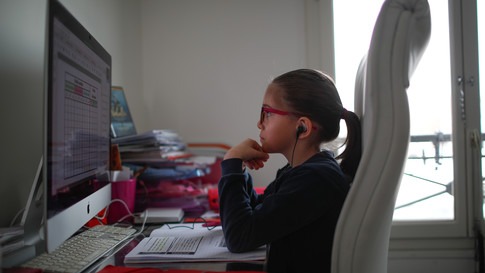
The new modality of virtual classes in which the student community is immersed due to the COVID-19 pandemic represents that children spend more time in front of a computer or cell phone; Although this brings multiple benefits in terms of skill development, it is necessary to take into account and promptly, simple actions to ensure the visual health of children.
Visual problems are one of the causes of school failure since 90% of information enters through the eyes. Poor academic performance, lack of concentration and attention, headaches, red eyes, and eye strain are warning signs of vision problems.
Despite these discomforts caused by vision limitations, children often hide them or do not realize they have them, which requires greater attention from parents. “One of the most important things in the learning process is a vision since the child uses his visual system to transport the information read to the brain, where it will be interpreted and analyzed. Poor vision triggers learning problems and school failure”, said Stephanie Acosta, an optometrist.
Given this, Acosta shares seven simple tips that parents or guardians of children can put into practice so that time in front of computers or electronic devices does not represent a danger for the proper functioning of vision.
Tips to protect children’s eyes when in front of a computer or smartphone

1. Ensure regular breaks. It is recommended that children take 20-second breaks for every 20 minutes of screen exposure. During this period of rest, they should look at objects that are 20 feet (or 6 meters) away. The eye rests seeing to afar.
2. Pay attention to good blinking and prevent children from developing continuous fixation.
3. Analyze and adjust the brightness and contrast of the screens used by the children so that they are in line with the lighting in the work area.
4. Avoid outdoor lighting when the child uses the computer; if possible, position your computer monitor or screen so that the windows are to the side, rather than in front of or behind it. Reflection off walls and surface finishes, as well as reflections on your computer screen, can also cause eye strain.
5. Keep the monitor about 60 to 70 centimeters away from children and slightly below their eye level.
6. If possible, adjust the font size when reading. Ask the child if he can easily read what is on the screen
7. Discuss the possibility of the child wearing glasses to protect his eyes from light exposure from screens or computers. These glasses do not contain prescription; they only have a filter for this type of brightness. It is important to note that to acquire them you must have the accompaniment of an expert. Those who have already graduated glasses can also include this filter, always under the guidance of an expert. If you are going to buy glasses for yourself, then why not save some money on your next pair?
Also, the expert in visual health shares the following signs that an alert that a child suffers from vision problems:
• Squinting: if the child does this constantly, it can be a sign that they have a vision problem since this movement gives them temporary relief.
• Tilt the head: this is compensation to try to correct astigmatism which consists of an irregularity of the cornea.
• Headaches: having headaches can be translated as an extra effort to compensate for blurred vision.
• Rubbing their eyes repeatedly throughout the day.

